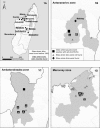First detection of African Swine Fever Virus in Ornithodoros porcinus in Madagascar and new insights into tick distribution and taxonomy
- PMID: 21118485
- PMCID: PMC3012664
- DOI: 10.1186/1756-3305-3-115
First detection of African Swine Fever Virus in Ornithodoros porcinus in Madagascar and new insights into tick distribution and taxonomy
Abstract
Background: African Swine Fever Virus has devastated more than the half of the domestic pig population in Madagascar since its introduction, probably in 1997-1998. One of the hypotheses to explain its persistence on the island is its establishment in local Ornithodoros soft ticks, whose presence has been reported in the past from the north-western coast to the Central Highlands. The aim of the present study was to verify such hypothesis by conducting tick examinations in three distinct zones of pig production in Madagascar where African Swine Fever outbreaks have been regularly reported over the past decade and then to improve our knowledge on the tick distribution and taxonomy.
Results: Ornithodoros ticks were only found in one pig farm in the village of Mahitsy, north-west of Antananarivo in the Central Highlands, whereas the tick seemed to be absent from the two other study zones near Ambatondrazaka and Marovoay. Using 16SrDNA PCR amplification and sequencing, it was confirmed that the collected ticks belonged to the O. porcinus species and is closely related to the O. p. domesticus sub-species Walton, 1962. ASFV was detected in 7.14% (13/182) of the field ticks through the amplification of part of the viral VP72 gene, and their ability to maintain long-term infections was confirmed since all the ticks came from a pig building where no pigs or any other potential vertebrate hosts had been introduced for at least four years.
Conclusions: Considering these results, O. porcinus is a reservoir for ASFV and most likely acts as vector for ASFV in Madagascar, but its apparent restricted distribution may limit its role in the epidemiology of the disease in domestic pigs.
Figures



References
-
- Arias M, Sanchez-Vizcaino JM. In: Trends in emerging viral infections of swine. Morilla A, Yoon KJ, Zimmerman JJ, editor. Ames: Iowa State University Press; 2000. African Swine Fever; pp. 119–124.
-
- Haresnape JM, Wilkinson PJ. A study of African swine fever virus infected ticks (Ornithodoros moubata) collected from three villages in the ASF enzootic area of Malawi following an outbreak of the disease in domestic pigs. Epidemiol Infect. 1989;102:507–522. doi: 10.1017/S0950268800030223. - DOI - PMC - PubMed
LinkOut - more resources
Full Text Sources
Miscellaneous

